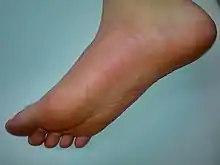पाँव
Hindi

पाँव
Alternative forms
- पांव (pāmv), पाँउ (pā̃u)
Etymology
Inherited from Sauraseni Prakrit 𑀧𑀸𑀅 (pāa), from Sanskrit पाद (pā́da) / पद् (pád, “foot”), from Proto-Indo-Aryan *pā́ts, from Proto-Indo-Iranian *pā́ts, and from Proto-Indo-European *pṓds. Compare Persian پا (pâ), Hittite [Term?] (/pata/), Latin pēs, pedis, Tocharian A pe, Tocharian B paiyye, Lithuanian pāda (“sole (foot)”), Russian под (pod, “ground”), Ancient Greek πούς, ποδός (poús, podós), Old Armenian ոտն (otn), English foot. Cognate with Marathi पाय (pāy).
Pronunciation
- (Delhi Hindi) IPA(key): /pɑ̃ːʋ/, [pä̃ːʋ], /pɑ̃ː.oː/, [pä̃ː.oː]
Noun
पाँव • (pā̃v) m (Urdu spelling پاؤں)
Declension
References
- Bahri, Hardev (1989) “पाँव”, in Siksarthi Hindi-Angrejhi Sabdakosa [Learners' Hindi-English Dictionary], Delhi: Rajpal & Sons.
- Platts, John T. (1884) “पाँव”, in A dictionary of Urdu, classical Hindi, and English, London: W. H. Allen & Co.
This article is issued from Wiktionary. The text is licensed under Creative Commons - Attribution - Sharealike. Additional terms may apply for the media files.